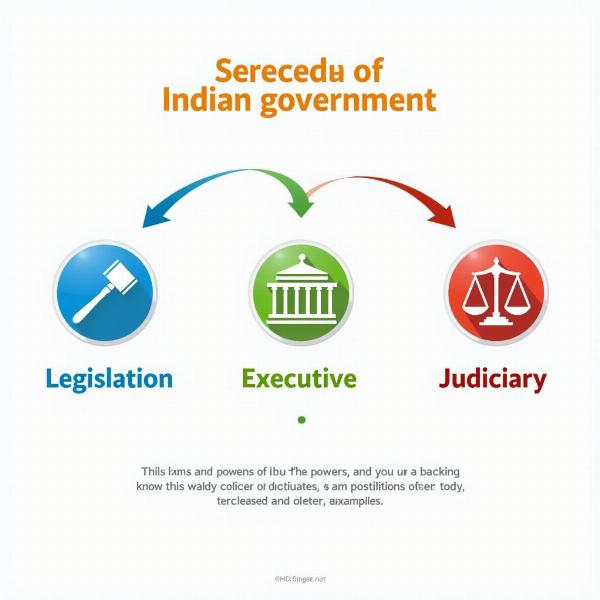Understanding the concept of “checks and balances” is crucial for comprehending democratic systems, particularly in the context of India’s vibrant political landscape. This principle ensures that no single branch of government becomes too powerful, promoting accountability and preventing tyranny. But what exactly does “checks and balances” mean in Hindi, and how does it apply to India’s governance?
Understanding “Checks and Balances” in the Indian Context
“Checks and balances” in Hindi can be translated as “नियंत्रण और संतुलन” (niyantran aur santulan). This phrase encapsulates the core idea of mutual oversight and control among different parts of the government. In India, these parts are the legislature (Parliament), the executive (Government), and the judiciary (Courts). Each branch has specific powers and responsibilities, but these powers are limited and balanced by the powers of the other branches.
 Checks and Balances in Indian Government
Checks and Balances in Indian Government
How Checks and Balances Work in India
The Indian Constitution meticulously outlines the system of checks and balances. For instance, the Parliament can impeach the President and remove judges through a defined process. This prevents the executive and judiciary from becoming unaccountable. Conversely, the President can veto legislation passed by Parliament, and the judiciary can review laws passed by Parliament and actions taken by the executive to ensure they are constitutional. This reciprocal oversight prevents any branch from exceeding its authority. It’s a delicate dance of power, designed to maintain equilibrium and protect democratic values.
The Importance of Checks and Balances in a Democracy
Why are checks and balances so crucial? Imagine a system without these checks. The executive could enforce laws arbitrarily, the legislature could pass oppressive laws without scrutiny, and the judiciary could interpret laws to favor certain groups. Checks and balances prevent this by fostering accountability and transparency. They ensure that all branches of government operate within the constitutional framework, upholding the rule of law and protecting citizens’ rights. This is particularly significant in a diverse country like India, where safeguarding minority rights and preventing majoritarian tyranny is paramount.
Examples of Checks and Balances in Action
Numerous examples illustrate the practical application of checks and balances in India. The Supreme Court’s striking down of certain sections of laws passed by Parliament demonstrates the judiciary’s power of judicial review. Similarly, Parliament’s scrutiny of government spending and its power to initiate no-confidence motions against the government illustrates legislative oversight over the executive. These examples demonstrate the dynamic interplay between the branches of government, constantly shaping and refining the application of checks and balances in real-time scenarios.
Checks and Balances vs. Separation of Powers: Understanding the Difference
While often used interchangeably, “checks and balances” and “separation of powers” are distinct concepts. Separation of powers refers to the division of governmental authority among different branches, while checks and balances describe the mechanisms that allow each branch to limit the power of the others. The former creates distinct roles, while the latter ensures that those roles are performed responsibly and within defined boundaries. In India, both principles are enshrined in the Constitution, working in tandem to safeguard democracy. A clear understanding of this nuanced difference is essential for grasping the intricacies of Indian polity. One might consider the indian polity meaning in hindi for further exploration.
Challenges to Checks and Balances in India
While India’s system of checks and balances has largely been successful, it faces ongoing challenges. Political polarization, executive overreach, and judicial activism are potential threats to this delicate balance. Maintaining a healthy democracy requires constant vigilance and a commitment to upholding the spirit of the Constitution. The ongoing dialogue surrounding these issues reinforces the importance of civic engagement and a deep understanding of these fundamental principles. You might also want to explore the implications of tyrannous meaning in hindi and hindi meaning of autocratic within this context.
Conclusion
“Checks and balances” (नियंत्रण और संतुलन) are the cornerstone of India’s democratic framework. They ensure accountability, prevent tyranny, and uphold the rule of law. Understanding this principle is crucial for every citizen. A robust system of checks and balances requires active participation from all stakeholders, including the government, judiciary, and citizens alike, to ensure its continued effectiveness and relevance in safeguarding India’s democratic future. For businesses operating within this framework, understanding the complexities of financial regulations is crucial, hence the importance of understanding terms like kiting meaning in hindi. Understanding the structure of government, such as the council of minister meaning in hindi, is also beneficial.
FAQ
- What is the Hindi meaning of “checks and balances”? नियंत्रण और संतुलन (niyantran aur santulan)
- Which branches of government are involved in checks and balances? The legislature, executive, and judiciary.
- Why are checks and balances important? They prevent any one branch of government from becoming too powerful.
- How does the judiciary check the legislature? Through judicial review, striking down unconstitutional laws.
- How does the legislature check the executive? Through no-confidence motions, scrutiny of government spending, and impeachment.
- What is the difference between checks and balances and separation of powers? Separation of powers divides governmental authority, while checks and balances provide mechanisms for each branch to limit the power of the others.
- What are some challenges to checks and balances in India? Political polarization, executive overreach, and judicial activism.
Meaning-Hindi.in is your trusted partner for accurate and culturally sensitive Hindi translations. We offer a wide range of translation services, including business and legal document translation, technical manual translation, website localization, and more. Our team of expert linguists ensures that your message is conveyed effectively while respecting the nuances of the Hindi language and Indian culture. Contact us today at [email protected] or +91 11-4502-7584 for all your Hindi translation needs. Meaning-Hindi.in will deliver the precise and professional translation services you require.